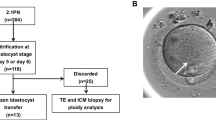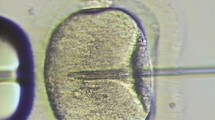Abstract
Purpose
The aim of the study is to report a case of non-diagnosed complex chromosomal rearrangement (CCR) identified by preimplantation genetic screening (PGS) followed by preimplantation genetic diagnosis (PGD) which resulted in a pregnancy and delivery of healthy offspring.
Methods
A 29-year-old woman and her spouse, both diagnosed previously with normal karyotypes, approached our IVF-PGD center following eight early spontaneous miscarriages. PGS using chromosomal microarray analysis (CMA) was performed on biopsied trophectoderm. Fluorescence in situ hybridization (FISH), as well as re-karyotype, were performed on metaphase derived from peripheral blood of the couple. Subsequently, in the following PGD cycle, a total of seven blastocysts underwent CMA.
Results
A gain or loss at three chromosomes (3, 7, 9) was identified in six out of seven embryos in the first PGS-CMA cycle. FISH analysis of parental peripheral blood samples demonstrated that the male is a carrier of a CCR involving those chromosomes; this was in spite of a former diagnosis of normal karyotypes for both parents. Re-karyotype verified the complex translocation of 46,XY,t (3;7;9)(q23;q22;q22). Subsequently, in the following cycle, a total of seven blastocysts underwent PGD-CMA for the identified complex translocation. Two embryos were diagnosed with balanced chromosomal constitution. A single balanced embryo was transferred and pregnancy was achieved, resulting in the birth of a healthy female baby.
Conclusions
PGS employing CMA is an efficient method to detect unrevealed chromosomal abnormalities, including complicated cases of CCR. The combined application of array CGH and FISH technologies enables the identification of an increased number of CCR carriers for which PGD is particularly beneficial.




Similar content being viewed by others
References
Brezina PR, Kutteh WH. Clinical applications of preimplantation genetic testing. BMJ. 2015;350:g7611.
Mastenbroek S, Twisk M, van der Veen F, Repping S. Preimplantation genetic screening: a systematic review and meta-analysis of RCTs. Hum Reprod Update. 2011;17(4):454–66.
Mastenbroek S, van der Veen F, Aflatoonian A, Shapiro B, Bossuyt P, Repping S. Embryo selection in IVF. Hum Reprod. 2011;26(5):964–6.
Fiorentino F, Spizzichino L, Bono S, Biricik A, Kokkali G, Rienzi L, et al. PGD for reciprocal and Robertsonian translocations using array comparative genomic hybridization. Hum Reprod. 2011;26(7):1925–35.
Gutierrez-Mateo C, Colls P, Sanchez-Garcia J, Escudero T, Prates R, Ketterson K, et al. Validation of microarray comparative genomic hybridization for comprehensive chromosome analysis of embryos. Fertil Steril. 2011;95(3):953–8.
Wells D, Alfarawati S, Fragouli E. Use of comprehensive chromosomal screening for embryo assessment: microarrays and CGH. Mol Hum Reprod. 2008;14(12):703–10.
Wells D, Patrizio P. Gene expression profiling of human oocytes at different maturational stages and after in vitro maturation. Am J Obstet Gynecol. 2008;198(4):455 e1–9. discussion 455 e9-11
Lathi RB, Westphal LM, Milki AA. Aneuploidy in the miscarriages of infertile women and the potential benefit of preimplanation genetic diagnosis. Fertil Steril. 2008;89(2):353–7.
Nonaka T, Ooki I, Enomoto T, Takakuwa K. Complex chromosomal rearrangements in couples affected by recurrent spontaneous abortion. Int J Gynaecol Obstet. 2015;128(1):36–9.
Munne S, Marquez C, Magli C, Morton P, Morrison L. Scoring criteria for preimplantation genetic diagnosis of numerical abnormalities for chromosomes X, Y, 13, 16, 18 and 21. Mol Hum Reprod. 1998;4(9):863–70.
Munne S, Wells D. Preimplantation genetic diagnosis. Curr Opin Obstet Gynecol. 2002;14(3):239–44.
Scriven PN. Communicating chromosome rearrangements and their outcomes using simple computer-generated color ideograms. Genet Test. 1998;2(1):71–4.
Scriven PN, Handyside AH, Ogilvie CM. Chromosome translocations: segregation modes and strategies for preimplantation genetic diagnosis. Prenat Diagn. 1998;18(13):1437–49.
Shpiz A, Kalma Y, Frumkin T, Telias M, Carmon A, Amit A, et al. Human embryonic stem cells carrying an unbalanced translocation demonstrate impaired differentiation into trophoblasts: an in vitro model of human implantation failure. Mol Hum Reprod. 2015;21(3):271–80.
Shaffer, L.G., McGowan-Jordan, J., Schmid, M., An International System for Human Cytogenetic Nomenclature (ISCN). 2013. Karger, 2013:140.
Francke U, Oliver N. Quantitative analysis of high-resolution trypsin-giemsa bands on human prometaphase chromosomes. Hum Genet. 1978;45(2):137–65.
Brezina PR, Kutteh WH, Bailey AP, Ke RW. Preimplantation genetic screening (PGS) is an excellent tool, but not perfect: a guide to counseling patients considering PGS. Fertil Steril. 2016;105(1):49–50.
Mastenbroek S, Repping S. Preimplantation genetic screening: back to the future. Hum Reprod. 2014;29(9):1846–50.
Pellestor F, Anahory T, Lefort G, Puechberty J, Liehr T, Hedon B, et al. Complex chromosomal rearrangements: origin and meiotic behavior. Hum Reprod Update. 2011;17(4):476–94.
Escudero T, Estop A, Fischer J, Munne S. Preimplantation genetic diagnosis for complex chromosome rearrangements. Am J Med Genet A. 2008;146A(13):1662–9.
Lim CK, Cho JW, Kim JY, Kang IS, Shim SH, Jun JH. A healthy live birth after successful preimplantation genetic diagnosis for carriers of complex chromosome rearrangements. Fertil Steril. 2008;90(5):1680–4.
Author information
Authors and Affiliations
Corresponding author
Rights and permissions
About this article
Cite this article
Frumkin, T., Peleg, S., Gold, V. et al. Complex chromosomal rearrangement—a lesson learned from PGS. J Assist Reprod Genet 34, 1095–1100 (2017). https://doi.org/10.1007/s10815-017-0954-y
Received:
Accepted:
Published:
Issue Date:
DOI: https://doi.org/10.1007/s10815-017-0954-y




